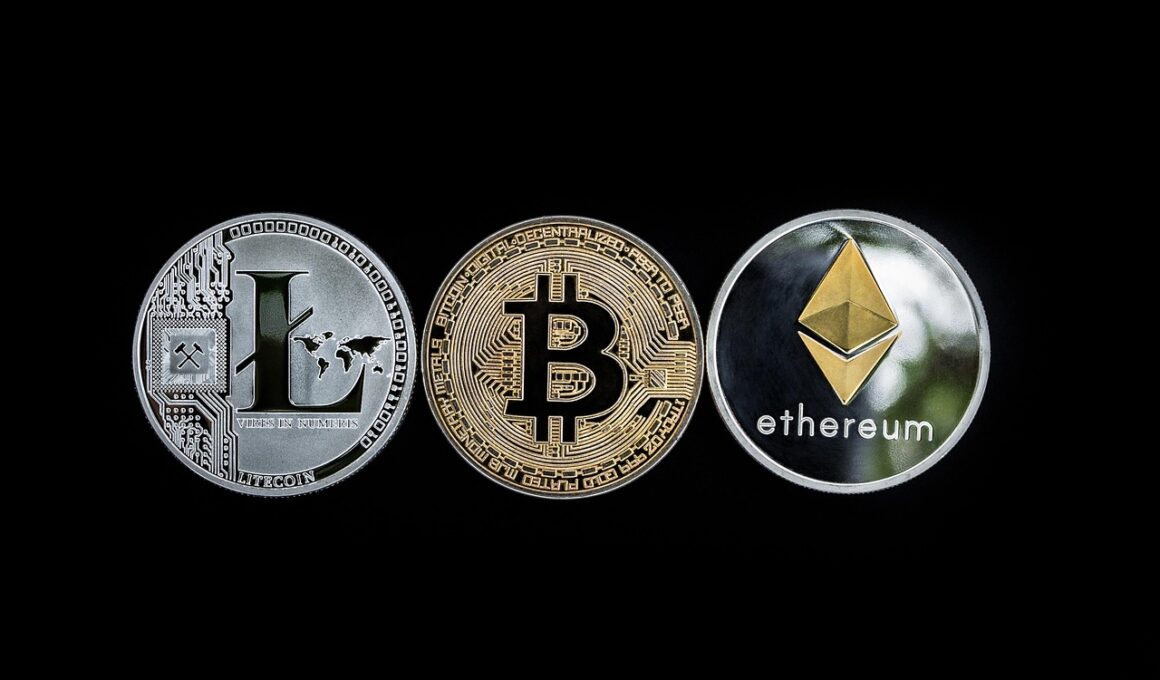The Future of Altcoins: Predictions and Expert Insights
The cryptocurrency landscape is evolving rapidly, with altcoins gaining traction and market share. As investors look beyond Bitcoin, several altcoins present unique opportunities for growth. Ethereum, for instance, is recognized for its smart contracts and decentralized applications. Meanwhile, stablecoins like Tether provide a bridge between fiat and crypto, reducing volatility risk. Other notable mentions in this space include Ripple for its cross-border payment solutions and Chainlink for decentralized data feeds. Experts suggest that the diversification of altcoins is pivotal to a balanced cryptocurrency portfolio. Altcoins often offer lower entry points and can deliver significant returns. However, the inherent risks and technological advancements in blockchain technology impact these assets greatly. The future of altcoins will likely hinge on regulatory developments and technological innovations. Understanding the fundamental utility and use case of each altcoin is essential for investors. Adopting a cautious yet optimistic approach might serve well in navigating this dynamic market. Staying informed through research and expert opinions can aid in making educated investment choices in the altcoin space.
Trends Driving Altcoin Adoption
One prominent trend driving altcoin adoption is the demand for unique blockchain solutions outside Bitcoin’s conventional approach. Altcoins like Cardano focus on scalability and sustainability, enticing environmentally conscious investors. The rise of decentralized finance (DeFi) platforms has further fueled interest, enabling users to lend, borrow, and trade without intermediaries. Additionally, NFTs have created new markets for art and gaming, prompting tokens designed for these ecosystems to gain recognition. Another trend is the increasing integration of cryptocurrencies into traditional financial systems. Major financial institutions are exploring blockchain technology, paving the way for altcoins to enter mainstream discussions. Cryptocurrency exchanges are also broadening their offerings, allowing users to access a variety of altcoins. Community-driven projects underscore the importance of engagement in the crypto space. As these projects build loyal followings, they can influence market trends substantially. Furthermore, education has become a crucial component in helping new investors navigate altcoins. The complexity of the technology often necessitates a supportive learning environment, enhancing user adoption and investment. A collaborative ecosystem involving developers, investors and regulators is essential for the sustainable growth of altcoins.
Market dynamics of altcoins are influenced considerably by investor sentiments and technological changes, creating fluctuations. Volatility in this realm is common, with market participants responding quickly to news, developments or partnerships. Recently, some altcoins have surged following announcements of integrations with major platforms or exchanges. The relationship between Bitcoin and altcoins often sets the tone for the broader market; thus, monitoring its price movements can guide investor expectations. Additionally, market capitalization plays a critical role in understanding the potential of an altcoin. Lower market cap coins can offer substantial returns but entail higher risk. Assessing trading volume can provide insights into liquidity and the overall interest in an altcoin. It’s vital for investors to conduct thorough research, considering both technical analysis and fundamental metrics. Furthermore, using social media channels is beneficial for gauging community sentiment. Various online platforms allow investors to track trends and share insights, often affecting market performance instantly. In conclusion, a balanced approach to understanding market dynamics could fortify investment positioning in the altcoin sector.
Regulatory Landscape and Its Impact
As the altcoin market continues to expand, the regulatory landscape is becoming increasingly pertinent. Governments worldwide are grappling with how to regulate cryptocurrencies, which directly affects altcoin viability. Regulatory clarity can cultivate investor confidence, attracting institutional money. Conversely, heavy-handed regulations may stifle innovation and deter participation in the crypto space. Additionally, compliance requirements can create burdens for altcoins, especially smaller projects that may struggle to meet stringent standards. An environment rich in collaboration between regulators and the cryptocurrency community can lead to more suitable guidelines. Furthermore, nations adopting favorable regulations can position themselves as hubs for crypto development, leading to technological advancements. Sanctions placed on certain cryptocurrencies can also influence market behavior significantly. Altcoins that find a niche in providing specific solutions may benefit in this evolving ecosystem. Therefore, investor awareness and adaptability to regulatory changes are paramount. Monitoring regulatory developments across different jurisdictions will help navigate potential impacts on altcoin investments. Overall, collaboration and mutual understanding between all stakeholders will be vital in shaping a balanced regulatory future that fosters growth and innovation.
Technological advancements in blockchain are continuously reshaping the future of altcoins. Innovations like layer-two scaling solutions, which improve transaction speeds and reduce fees, are becoming GAME CHANGERS for many altcoins. As transaction challenges arise, scalable solutions are paramount. Furthermore, developments in interoperability between different blockchains allow altcoins to communicate more efficiently. For example, projects like Polkadot aim to facilitate cross-chain transfers, improving the functionality of various altcoins. Additionally, improvements in security protocols are vital for maintaining user trust and minimizing fraud. Altcoins that prioritize security features can attract institutional investors looking for safe investment options. Adoption of decentralized governance models also presents new ways for stakeholders to participate in project developments. Such models empower communities, aligning user interests with project progress. The role of decentralized autonomous organizations (DAOs) is also gaining popularity, reshaping organizational structures within the crypto space. Overall, these technological shifts will likely affect altcoin adoption and retention, creating a more dynamic and competitive market. Staying abreast of technological innovations can equip investors to make informed decisions moving forward.
Investment Strategies for Altcoins
Investing in altcoins requires a different approach when compared to traditional assets. Many investors utilize a diversified strategy to manage risks, spreading investments across various altcoins to mitigate potential losses from underperforming assets. Analyzing each altcoin’s use case and technology is essential to determine potential longevity and utility. Additionally, many investors use dollar-cost averaging to build long-term positions gradually. This strategy limits exposure to volatility and eases the anxiety of market fluctuations. Utilizing portfolio trackers and analytics can help monitor performance and make adjustment decisions effectively. Researchers recommend keeping a keen eye on community engagement in projects, as active participation can indicate strong fundamentals. Investors should also keep abreast of industry news and developments affecting the broader crypto landscape. Furthermore, participating in discussions on forums or social media platforms can provide insights not readily available through traditional research methods. Lastly, forming connections with expert traders or utilizing signals from knowledgeable sources can enhance trading success. Altcoin investment strategies must be guided by patience and informed decision-making for long-term sustainability and growth.
The outlook for altcoins appears promising, driven by continual advancements in technology and growing market awareness. As more individuals and institutions embrace cryptocurrencies, the altcoin ecosystem is expected to flourish. The focus on regulatory clarity can enhance adoption, ensuring a stable investing environment. Innovations such as DeFi and NFTs have already expanded altcoin potential to unprecedented levels. Moreover, altcoins are gradually moving towards becoming integral components of numerous industries. The emergence of emerging technologies like artificial intelligence can shake up the altcoin market, potentially giving birth to new applications and use cases. It is essential for investors to remain adaptable and informed about market shifts, maintaining flexibility to seize opportunities. Community engagement is becoming ever more critical as projects rely on participant involvement for momentum. Looking ahead, altcoins equipped with solid fundamentals, innovative technology and an active community may stand out in the competitive landscape. Ultimately, patience and a long-term vision will be vital for navigating this continuously evolving market. Placing trust in thorough research combined with strategic approaches can support fruitful investment journeys in the realm of altcoins.
Conclusion
The future of altcoins brings both challenges and opportunities, demanding careful consideration from investors. Understanding the unique characteristics and market dynamics is necessary to maximize returns and minimize risks. As altcoins continue to play a critical role in the cryptocurrency ecosystem, investors should remain informed about evolving trends, regulations and technological advancements. Collaborating with community stakeholders and regulators will also be necessary to foster a thriving environment for altcoin development. Furthermore, adopting sound investment strategies tailored to the altcoin market can empower investors to navigate this vibrant space intelligently. As technology permeates nearly every aspect of our lives, the role of altcoins is likely to become more pronounced in future financial landscapes. Therefore, continuing to educate oneself and engage with the cryptocurrency community is paramount for making informed decisions. Ultimately, the potential for significant growth, innovation, and participation in this sector makes altcoins an exciting area for future investments. The groundwork laid today will shape the landscape of cryptocurrency tomorrow, making awareness and proactive engagement crucial in positioning effectively in the altcoin market.


